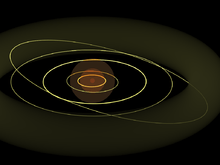1 terametre

8 things in the Terameter group

Click on the thumbnail image to jump to the desired order of length magnitude: top-left is 1e6m, lower-right is 1e17m. (Image description)

Comparison of size of the Kuiper belt (large faint torus) with the star VY Canis Majoris (at its previous estimate, within Saturn's orbit), Betelgeuse (inside Jupiter's orbit) and R Doradus (small central red sphere) together with the orbits of Neptune and Uranus, to scale. The yellow ellipses represent the orbits of each planet and the dwarf planet Pluto.
To help compare different distances, this page lists lengths starting at 1012 m (1 Tm or 1,000 million km or 6.7 astronomical units). Less than 1 Terameter from earth to the Sun Distances shorter than 1012 m
- 1.079 Tm — 7.2 AU — One light-hour
- 1.4 Tm — 9.5 AU — Distance between Saturn and the Sun
- 1.97 Tm — 13.2 AU — revised estimated diameter of VY Canis Majoris. The newly improved measurement was 30% lower than the previous 2007 estimate.[1]
- 2.0 Tm — 13.4 AU — Diameter of one of the largest known stars, KY Cygni
- 2.4 Tm — 15.9 AU — estimated diameter of UY Scuti, the largest known star as of 2013
- 2.8 Tm — 18.72 AU — previous estimated diameter of VY Canis Majoris, as of 2007.[2] The size was revised in 2012 through improved measurement techniques.[1]
- 2.9 Tm — 19.4 AU — Distance between Uranus and the Sun
- 4.4 Tm — 29.4 AU — Perihelion distance of Pluto
- 4.5 Tm — 30.1 AU — Distance between Neptune and the Sun
- 4.5 Tm — 30.1 AU — Inner radius of the Kuiper belt
- 5.7 Tm — 38.1 AU — Perihelion distance of Eris
- 7.3 Tm — 48.8 AU — Aphelion distance of Pluto
- 7.5 Tm — 50.1 AU — Outer radius of the Kuiper Belt, inner boundary of the Oort Cloud
Distances longer than 1013 m
See also
Notes
- ↑ 1.0 1.1 Wittkowski, M.; Hauschildt, P.H.; Arroyo-Torres, B.; Marcaide, J.M. (5 April 2012). "Fundamental properties and atmospheric structure of the red supergiant VY CMa based on VLTI/AMBER spectro-interferometry". Astronomy & Astrophysics 540: L12. arXiv:1203.5194. Bibcode:2012A&A...540L..12W. doi:10.1051/0004-6361/201219126.
- ↑ Humphreys, Roberta (13 October 2006). "VY Canis Majoris: the astrophysical basis of its luminosity". arXiv:astro-ph/0610433.
| ||||||||||
| ||||||||||